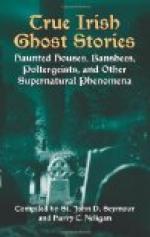On walking down the corridor, I have heard a door open, a footstep cross before me, and go into another room, both doors being closed at the time. An old cook I had told me that when she went into the hall in the morning, a gentleman would come down the front stairs, take a plumed hat off the stand, and vanish through the hall door. This she saw nearly every morning. She also said that a girl often came into her bedroom, and put her hand on her (the cook’s) face; and when she would push her away she would hear a girl’s voice say, “Oh don’t!” three times. I have often heard voices in the drawing-room, which decidedly sounded as if an old gentleman and a girl were talking. Noises like furniture being moved were frequently heard at night, and strangers staying with us have often asked why the servants turned out the rooms underneath them at such an unusual hour. The front-door bell sometimes rang, and I have gone down, but found no one.
Yours very sincerely,
F.T.
“Kilman” Castle, in the heart of Ireland—the name is obviously a pseudonym—has been described as perhaps the worst haunted mansion in the British Isles. That it deserves this doubtful recommendation, we cannot say; but at all events the ordinary reader will be prepared to admit that it contains sufficient “ghosts” to satisfy the most greedy ghost-hunter. A couple of months ago the present writer paid a visit to this castle, and was shown all over it one morning by the mistress of the house, who, under the nom de plume of “Andrew Merry” has published novels dealing with Irish life, and has also contributed articles on the ghostly phenomena of her house to the Occult Review (Dec. 1908 and Jan. 1909).
The place itself is a grim, grey, bare building. The central portion, in which is the entrance-hall, is a square castle of the usual type; it is built on a rock, and a slight batter from base to summit gives an added appearance of strength and solidity. On either side of the castle are more modern wings, one of which terminates in what is known as the “Priest’s House.”
Now to the ghosts. The top storey of the central tower is a large, well-lighted apartment, called the “Chapel,” having evidently served that purpose in times past. At one end is what is said to be an oubliette, now almost filled up. Occasionally in the evenings, people walking along the roads or in the fields see the windows of this chapel lighted up for a few seconds as if many lamps were suddenly brought into it. This is certainly not due to servants; from our experience we can testify that it is the last place on earth that a domestic would enter after dark. It is also said that a treasure is buried somewhere in or around the castle. The legend runs that an ancestor was about to be taken to Dublin on a charge of rebellion, and, fearing he would never return, made the best of the time left to him by burying somewhere a crock full




